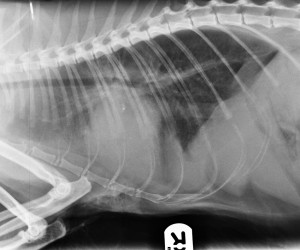Clinical Vignette: Congestive Heart Failure in a Cat
A 3 year old male Maine coon cat was presented for investigation of reduced appetite and his owner had also noticed changes in behaviour such as hiding in a cupboard for 2 days.Cardiac auscultation revealed tachycardia and a gallop sound but no obvious murmur or arrhythmia. Following partial improvement after treatment with frusemide and benazepril, the cat was referred for further investigation.The lateral thoracic radiograph from this case illustrates cardiomegaly with enlarged lobar vessels and an interstitial pattern suggestive of cardiogenic pulmonary oedema. The thorax also appears over-inflated probably due to dyspnoea.The echocardiography image (top right) shows concentric hypertrophy of the left ventricle and marked left atrial enlargement. Subjectively there also appears to be mild concentric hypertrophy of the right ventricle.

These findings are consistent with hypertrophic cardiomyopathy resulting in signs of severe congestive heart failure.
The cat was treated with frusemide, benazepril and aspirin. Spironolactone was not used due to difficulties administering oral medication and also the risk of severe facial dermatitis in this breed.
Key points
- The presenting signs of congestive heart failure in cats are more subtle than in dogs
- Not all cats with congestive heart failure will have an audible heart murmur
- Radiographic signs of congestive heart failure in cats are different to dogs
- Hypertrophic cardiomyopathy is a recognised problem in this breed and a young age at onset tends to be a poor prognostic sign

